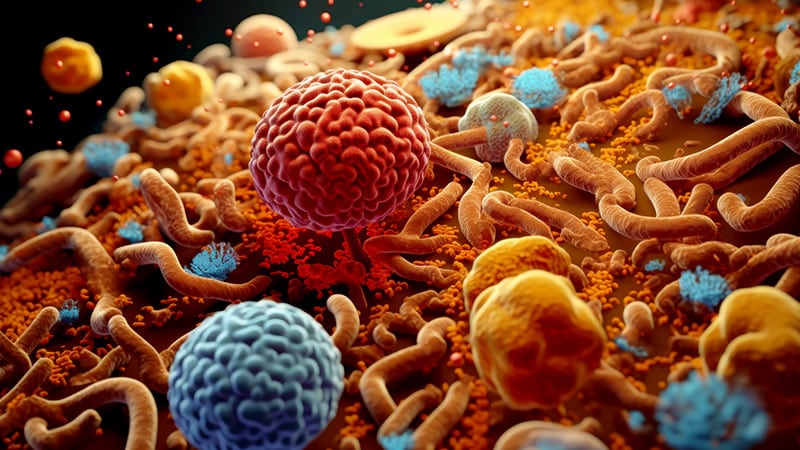Gut Microbiome Alterations Associated with Growth Hormone Deficiency in Children
Core Concepts
Children with growth hormone deficiency (GHD) exhibit distinct gut microbiome and metabolite profiles compared to those with idiopathic short stature (ISS) and healthy controls, suggesting a potential interaction between the gut microbiome and growth hormone levels.
Abstract
This study investigated the gut microbiome and metabolome profiles of children with GHD, ISS, and healthy controls. The key findings are:
Children with GHD had significantly higher body mass index, lower peak growth hormone levels, and higher cholesterol levels compared to those with ISS.
While the overall microbial diversity (alpha diversity) was similar across the groups, there were significant differences in the taxonomic composition (beta diversity) of the gut microbiome.
Specific microbial taxa, such as decreased Pelomonas, Rodentibacter, and Rothia, and increased Prevotellaceae_NK3B31_group, were observed in both GHD and ISS groups compared to healthy controls.
The Firmicutes/Bacteroidota (F/B) ratio, which may be linked to longevity, was decreased in the short stature groups, particularly in GHD.
Certain microbes, like Nocardioides in ISS and Fusobacterium mortiferum in GHD, were identified as potential "critical intestinal factors" contributing to short stature.
Metabolomic analysis revealed differences in glucose, pyruvate, and pyrimidine metabolism between the groups.
A panel of 13 microbiome and metabolome markers was able to accurately distinguish between GHD and ISS with high sensitivity and specificity.
These findings provide novel insights into the potential role of the gut microbiome in the pathogenesis of short stature associated with growth hormone deficiency, and suggest possible avenues for early diagnosis and innovative treatment approaches, such as fecal microbiota transplantation.
Microbiome Alterations Link to Growth Hormone Deficiency
Stats
Children with GHD had significantly higher body mass index than those with ISS (p < 0.05).
The peak growth hormone level was significantly lower in the GHD group compared to the ISS group (p < 0.001).
Patients with GHD had significantly higher total cholesterol and LDL cholesterol levels than patients with ISS (p < 0.05).
Quotes
"These findings provide novel insights into potential early diagnosis and innovative treatment alternatives, such as fecal microbiota transplantation, for short stature with varying growth hormone levels."
"It would be really, really interesting and helpful to have a microbiome signature that allows you to distinguish between true growth hormone deficiency and patients with idiopathic short stature."
Key Insights Distilled From
by Liam Davenpo... at www.medscape.com 04-19-2024
https://www.medscape.com/viewarticle/microbiome-alterations-link-growth-hormone-deficiency-2024a10007kp
Deeper Inquiries
How do the identified microbial and metabolic signatures relate to the underlying mechanisms linking the gut microbiome and the growth hormone/IGF-1 axis?
The microbial and metabolic signatures identified in the study provide insights into the potential interactions between the gut microbiome and the growth hormone/IGF-1 axis. The alterations in microbial populations, such as the decreased abundance of Pelomonas, Rodentibacter, and Rothia, and the increased abundance of Prevotellaceae_NK3B31_group in children with growth hormone deficiency (GHD), suggest a dysregulation in the gut microbiota composition. These changes may impact the production and metabolism of microbial metabolites, which in turn could influence the growth hormone/IGF-1 axis. For example, the decreased Firmicutes/Bacteroidota (F/B) ratio observed in participants with short stature, particularly in the GHD group, is significant as this ratio has been linked to longevity. Additionally, the presence of specific microbial species like Nocardioides and Fusobacterium mortiferum in different groups indicates a potential role of these microbes in contributing to the observed differences in growth patterns.
What are the potential confounding factors, such as diet, antibiotic use, and geographic location, that need to be carefully controlled in future studies to validate the microbiome-growth hormone relationship?
Several confounding factors need to be carefully controlled in future studies to validate the relationship between the gut microbiome and growth hormone levels. Diet plays a crucial role in shaping the composition of the gut microbiota, so variations in dietary habits among study participants could influence the results. Antibiotic use can also disrupt the gut microbiome, leading to changes that may confound the association with growth hormone levels. Moreover, geographic location can impact the microbial diversity of individuals due to environmental factors and lifestyle differences. Therefore, future studies should consider standardizing dietary intake, accounting for antibiotic exposure history, and possibly including participants from similar geographic regions to minimize the impact of these confounding variables on the microbiome-growth hormone relationship.
Could the gut microbiome-based biomarkers identified in this study be leveraged to develop non-invasive diagnostic tools for growth hormone deficiency in children?
The gut microbiome-based biomarkers identified in this study hold promise for the development of non-invasive diagnostic tools for growth hormone deficiency in children. The panel of 13 microbiome and metabolome markers that could discriminate between GHD and idiopathic short stature (ISS) with high sensitivity and specificity is a significant finding. By leveraging these biomarkers, it may be possible to create diagnostic tests that utilize fecal samples to assess the microbial and metabolic signatures associated with GHD. This non-invasive approach could offer a more accessible and potentially more accurate method for diagnosing growth hormone deficiency in children, especially if validated in larger cohorts and diverse populations. However, further research and validation studies are necessary to confirm the utility and reliability of these gut microbiome-based biomarkers as diagnostic tools for GHD.
0
